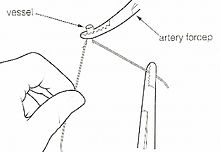Ligature (medicine)

This article needs more primary sources. (February 2022) |  |
In surgery or medical procedure, a ligature consists of a piece of thread (suture) tied around an anatomical structure, usually a blood vessel, another hollow structure (e.g. urethra) or an accessory skin tag to shut it off.
History
The principle of ligation is attributed to
Procedure
With a blood vessel the surgeon will clamp the vessel perpendicular to the axis of the artery or vein with a hemostat, then secure it by ligating it; i.e. using a piece of suture around it before dividing the structure and releasing the hemostat. It is different from a tourniquet in that the tourniquet will not be secured by knots and it can therefore be released/tightened at will.
Ligation is one of the remedies to treat skin tag, or acrochorda. It is done by tying string or dental floss around the acrochordon to cut off the blood circulation.[6] Home remedies include commercial ligation bands that can be placed around the base of skin tags.[7]
Complications of ligation in polydactyly treatment include infection, neuroma or cyst formation.[8]
See also
- Elastrator
- Surgical suture
- Cheesewiring
References
- ^ Lois N. Magner (1992). A History of Medicine. CRC Press. p. 91.
- ISBN 9781879284173. Retrieved 2 November 2012.
- ISBN 978-1-85233-496-3.
- ISBN 978-0-8160-4887-8.
- ^ Paget, Stephen (1897). Ambroise Paré and his times, 1510-1590. G.P. Putnam's Sons. p. 23. Retrieved 2 November 2012.
- ^ "Cutaneous skin tag". Medline Plus. Retrieved 20 August 2012.
- ^ MHS, Kristina Liu, MD (March 23, 2020). "Skin tag removal: Optional but effective". Harvard Health.
{{cite web}}: CS1 maint: multiple names: authors list (link) - )
